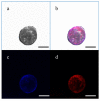Biodegradable Nanoparticles-Loaded PLGA Microcapsule for the Enhanced Encapsulation Efficiency and Controlled Release of Hydrophilic Drug
- PMID: 33801871
- PMCID: PMC7998393
- DOI: 10.3390/ijms22062792
Biodegradable Nanoparticles-Loaded PLGA Microcapsule for the Enhanced Encapsulation Efficiency and Controlled Release of Hydrophilic Drug
Abstract
Recently, nano- and micro-particulate systems have been widely utilized to deliver pharmaceutical compounds to achieve enhanced therapeutic effects and reduced side effects. Poly (DL-lactide-co-glycolide) (PLGA), as one of the biodegradable polyesters, has been widely used to fabricate particulate systems because of advantages including controlled and sustained release, biodegradability, and biocompatibility. However, PLGA is known for low encapsulation efficiency (%) and insufficient controlled release of water-soluble drugs. It would result in fluctuation in the plasma levels and unexpected side effects of drugs. Therefore, the purpose of this work was to develop microcapsules loaded with alginate-coated chitosan that can increase the encapsulation efficiency of the hydrophilic drug while exhibiting a controlled and sustained release profile with reduced initial burst release. The encapsulation of nanoparticles in PLGA microcapsules was done by the emulsion solvent evaporation method. The encapsulation of nanoparticles in PLGA microcapsules was confirmed by scanning electron microscopy and confocal microscopy. The release profile of hydrophilic drugs can further be altered by the chitosan coating. The chitosan coating onto alginate exhibited a less initial burst release and sustained release of the hydrophilic drug. In addition, the encapsulation of alginate nanoparticles and alginate nanoparticles coated with chitosan in PLGA microcapsules was shown to enhance the encapsulation efficiency of a hydrophilic drug. Based on the results, this delivery system could be a promising platform for the high encapsulation efficiency and sustained release with reduced initial burst release of the hydrophilic drug.
Keywords: PLGA; alginate; chitosan; controlled release; hydrophilic drug encapsulation; microcapsule; nanoencapsulation.
Conflict of interest statement
The authors declare no conflict of interest.
Figures








Similar articles
-
Tunable sustained release drug delivery system based on mononuclear aqueous core-polymer shell microcapsules.Int J Pharm. 2019 Mar 10;558:291-298. doi: 10.1016/j.ijpharm.2019.01.006. Epub 2019 Jan 12. Int J Pharm. 2019. PMID: 30641178
-
PTX-loaded three-layer PLGA/CS/ALG nanoparticle based on layer-by-layer method for cancer therapy.J Biomater Sci Polym Ed. 2018 Sep;29(13):1566-1578. doi: 10.1080/09205063.2018.1475941. Epub 2018 May 17. J Biomater Sci Polym Ed. 2018. PMID: 29749303
-
Improved mucoadhesion and cell uptake of chitosan and chitosan oligosaccharide surface-modified polymer nanoparticles for mucosal delivery of proteins.Drug Deliv Transl Res. 2016 Aug;6(4):365-79. doi: 10.1007/s13346-016-0295-x. Drug Deliv Transl Res. 2016. PMID: 27106502
-
Microencapsulation of protein drugs for drug delivery: strategy, preparation, and applications.J Control Release. 2014 Nov 10;193:324-40. doi: 10.1016/j.jconrel.2014.09.003. Epub 2014 Sep 10. J Control Release. 2014. PMID: 25218676 Review.
-
Nano/micro technologies for delivering macromolecular therapeutics using poly(D,L-lactide-co-glycolide) and its derivatives.J Control Release. 2008 Feb 11;125(3):193-209. doi: 10.1016/j.jconrel.2007.09.013. Epub 2007 Oct 22. J Control Release. 2008. PMID: 18083265 Review.
Cited by
-
Synergistic Therapy of Melanoma by Co-Delivery of Dacarbazine and Ferroptosis-Inducing Ursolic Acid Using Biomimetic Nanoparticles.ACS Omega. 2024 Sep 24;9(40):41532-41543. doi: 10.1021/acsomega.4c05209. eCollection 2024 Oct 8. ACS Omega. 2024. PMID: 39398166 Free PMC article.
-
Progress in the Preparation and Applications of Microcapsules for Protective Coatings Against Corrosion.Int J Mol Sci. 2025 Feb 10;26(4):1473. doi: 10.3390/ijms26041473. Int J Mol Sci. 2025. PMID: 40003938 Free PMC article. Review.
-
Physical, Chemical, and Biological Properties of Chitosan-Coated Alginate Microparticles Loaded with Porcine Interleukin-1β: A Potential Protein Adjuvant Delivery System.Int J Mol Sci. 2022 Sep 1;23(17):9959. doi: 10.3390/ijms23179959. Int J Mol Sci. 2022. PMID: 36077367 Free PMC article.
-
Influence of Rhamnolipids and Ionic Cross-Linking Conditions on the Mechanical Properties of Alginate Hydrogels as a Model Bacterial Biofilm.Int J Mol Sci. 2021 Jun 25;22(13):6840. doi: 10.3390/ijms22136840. Int J Mol Sci. 2021. PMID: 34202115 Free PMC article.
-
Azithromycin-loaded PLGA microspheres coated with silk fibroin ameliorate inflammation and promote periodontal tissue regeneration.Regen Biomater. 2024 Dec 14;12:rbae146. doi: 10.1093/rb/rbae146. eCollection 2025. Regen Biomater. 2024. PMID: 39791015 Free PMC article.
References
-
- Koenig W. Efficacy and Tolerability of Metoprolol Tartrate in Patients with Mild-to-Moderate Essential Hypertension: A Randomised, Double-Blind, Multicentre Trial. Clin. Drug Investig. 2001;21:613–619. doi: 10.2165/00044011-200121090-00003. - DOI
MeSH terms
Substances
Grants and funding
LinkOut - more resources
Full Text Sources
Other Literature Sources
Medical

